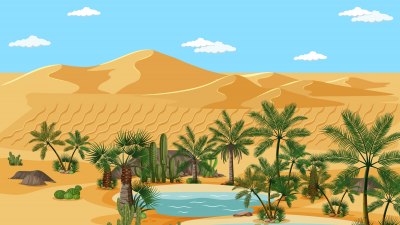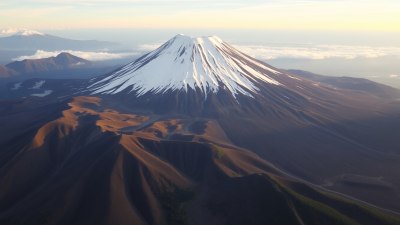Why This Desert Oasis Feels Like Another Planet - And How to Visit It
Explore the otherworldly beauty of desert oases and how to experience them like never before.

The concept of a desert oasis evokes images of verdant greenery amid arid expanses, but one could easily argue that these unique ecosystems feel like another planet altogether. Oases transport visitors to a world where time seems to stand still, surrounded by the breathtaking juxtaposition of vibrant life thriving against a backdrop of endless wasteland. In this article, we will explore why these enchanting places feel so alien and how you can visit some of the most impressive oases in the world.
The Allure of the Oasis
Oases are more than just sources of water; they are lifelines in the heart of deserts that sustain diverse flora and fauna. The stark contrast between the harsh desert landscape and the lush vegetation creates a surreal experience that can be likened to stepping onto another planet. These fertile spots emerge in various remarkable shapes and sizes, ranging from small pools surrounded by palm trees to expansive fertile regions where agriculture flourishes. Their allure lies not only in their beauty but also in their unique ecosystems, which adapt to the harshest of conditions. The vibrant colors, unusual rock formations, and captivating wildlife found in such locations can be mesmerizing, contributing to the otherworldly atmosphere.
The Science Behind Oases
Geographically, an oasis forms when underground water sources, such as aquifers, are pushed to the surface through natural springs or are intercepted by humans through wells. Such phenomena nurture life where it would otherwise be impossible. In regions like the Sahara Desert, you can find oases nestled among towering sand dunes, while in other deserts like the Mojave, they might be surrounded by rocky outcrops. Understanding the geological and hydrological processes that create these phenomenons adds depth to the experience of visiting an oasis. They serve as powerful reminders of nature's resilience and the interconnectedness of ecosystems.
The Visual Spectacle of Oases
One of the first sensations you'll experience upon reaching an oasis is visual awe. Oasis landscapes are characterized by a rich palette of colors that stand in stark contrast to the muted tones of the desert. Golden sands, vibrant greens, and deep blues blend into a breathtaking scene that defies ordinary perception. Imagine walking among swaying palm trees, their fronds catching the sunlight, while water ripples gracefully nearby. Photographers often describe oases as “dreamlike,” and for good reason: the shifting light throughout the day transforms the scenery into constantly changing artwork. At dusk or dawn, oases appear almost ethereal, with colors intensifying in the soft light.
Unique Flora and Fauna
The biodiversity of oases is another reason they feel otherworldly. These areas generally host a species-rich environment with plants and animals adapted specifically to survive in harsh conditions. Fig trees, date palms, and various aquatic plants often flourish around the water, creating mini-ecosystems. Animals, on the other hand, might include migratory birds drawn to the water source, reptiles basking in the sun, or nocturnal creatures emerging at night to take advantage of the unique ecological niche. Observing wildlife in their natural habitat can feel like venturing into a completely different world, where life takes on an intriguing form that feels almost alien.
Cultural Significance of Oases
Beyond their stunning landscapes and surprising biodiversity, oases carry rich cultural significance. Civilizations have historically gravitated towards these fertile pockets, building communities that rely on the life-giving properties of water. Many oases have served as important trade routes, connecting distant regions and enabling cultural exchanges that shaped history. When visiting an oasis, you can find remnants of ancient architecture, thriving markets, and cultural festivals that celebrate the history of the land. Meeting local communities allows for an immersive experience, as you learn about traditional customs and practices intimately tied to the water sources that sustain them. The cultural richness surrounding oases adds another layer of wonder to these already extraordinary environments.
How to Visit a Desert Oasis
Now that we've explored the mystery and allure of oases, let's discuss how to visit them. There are several remarkable oases across the globe, each offering a unique experience. One of the most famous is the Siwa Oasis in Egypt, known for its striking landscapes, ancient ruins, and therapeutic hot springs. An excellent starting point for your oasis exploration adventure is the Libyan border, just a short drive from the city of Cairo. Accommodation in eco-lodges or local guesthouses provides an opportunity to connect with the local culture while embracing sustainable tourism practices.
Planning Your Trip
When planning your trip, consider visiting during cooler months for pleasant weather that enhances your experience of the scenery. The best months typically range from late autumn to early spring. Engage in hiking or guided tours to explore the immediate area surrounding the oasis, stretching your adventure into nearby desert terrains or mountains. Don’t forget to pack plenty of water, sunscreen, and camera gear; the landscapes you’ll encounter need to be captured! Additionally, researching local traditions can help you gain respect and understanding of the cultural significance of the land you’re visiting.
Alternative Destinations
If you are looking for otherworldly oases beyond Egypt, consider the Al Ain Oasis in the United Arab Emirates, a UNESCO World Heritage site renowned for its palm groves and ancient falaj irrigation system. Alternatively, the Huacachina Oasis in Peru features beautiful sand dunes, offering thrilling experiences like sandboarding or dune buggy rides. Each of these oases has its unique characteristics, promising a surreal escape that feels distinctly separate from our everyday lives.
Sustainable Tourism and Oases
When visiting oases, it's important to practice sustainable tourism. These unique ecosystems are delicate and can easily be undermined by human activity. Opting to stay in eco-friendly accommodations and participating in responsible tourism activities can minimize your impact on the environment. Take care not to disturb wildlife or damage the plants; instead, leave nothing but footprints and take nothing but photographs. Engage with local communities in ways that benefit them directly, thereby enhancing your travel experience while supporting conservation efforts.
The Lasting Impact of Oases
Desert oases hold immense potential for inspiration, creativity, and introspection. Their otherworldly charm captivates visitors and forces contemplation about nature's fragility and resilience. A visit to an oasis isn’t merely a journey to a visually stunning location, but an invitation to experience the richness of life in harmony with seemingly inhospitable environments. Whether it’s the lush greenery framed against an endless desert or rich local traditions that breathe life into the water’s edge, desert oases inspire admiration for the natural world. By connecting in meaningful ways with the landscapes and communities you encounter, your journey will become one of continued wonder and reflection.











